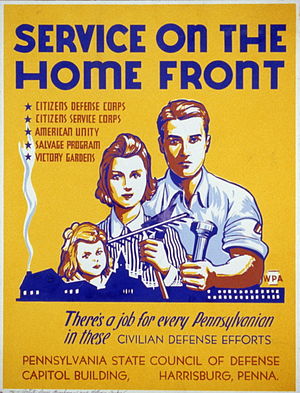United States home front during World War II

Service on the Home Front by Louis Hirshman and William Tasker.
|
|
| Date | 1941–45 |
|---|---|
| Location | United States |
The home front of the United States in World War II supported the war effort in many ways, including a wide range of volunteer efforts and submitting to government-managed rationing and price controls. Everyone agreed that the sacrifices were for the national good "for the duration."
The labor market changed radically. Peacetime conflicts with respect to race and labor took on a special dimension because of the pressure for national unity. The Hollywood film industry was important for propaganda. Every aspect of life from politics to personal savings changed when put on a wartime footing. This was achieved by tens of millions of workers moving from low to high productivity jobs in industrial centers. Millions of students, retirees, housewives, and unemployed moved into the active labor force. Hours worked increased as leisure activities declined sharply.
Gasoline, meat, and clothing were tightly rationed. Most families were allocated 3 US gallons (11 l; 2.5 imp gal) of gasoline a week, which sharply curtailed driving for any purpose. Production of most durable goods, like cars, new housing, vacuum cleaners, and kitchen appliances, was banned until the war ended. In industrial areas housing was in short supply as people doubled up and lived in cramped quarters. Prices and wages were controlled. Americans saved a high portion of their incomes, which led to renewed growth after the war.
Federal tax policy was highly contentious during the war, with President Franklin D. Roosevelt battling a conservative Congress. However, both sides agreed on the need for high taxes (along with heavy borrowing) to pay for the war: top marginal tax rates ranged from 81%-94% for the duration of the war, and the income level subject to the highest rate was lowered from $5,000,000 to $200,000. Roosevelt tried unsuccessfully, by executive order 9250, to impose a 100% surtax on after-tax incomes over $25,000 (equal to roughly $346,010 today). However, Roosevelt did manage to impose this cap on executive pay in corporations with government contracts. Congress also enlarged the tax base by lowering the minimum income to pay taxes, and by reducing personal exemptions and deductions. By 1944 nearly every employed person was paying federal income taxes (compared to 10% in 1940).
Many controls were put on the economy. The most important were price controls, imposed on most products and monitored by the Office of Price Administration. Wages were also controlled. Corporations dealt with numerous agencies, especially the War Production Board (WPB), and the War and Navy departments, which had the purchasing power and priorities that largely reshaped and expanded industrial production.
...
Wikipedia
